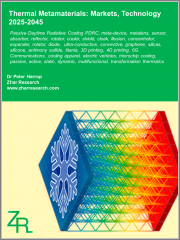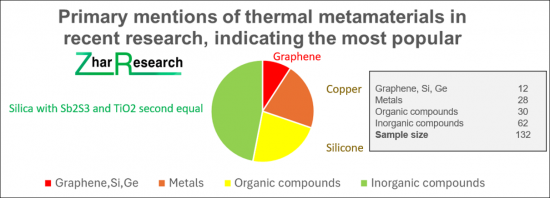
|
시장보고서
상품코드
1615495
열 메타물질 : 시장 및 기술(2025-2045년)Thermal Metamaterials: Markets, Technology 2025-2045 |
||||||
열 메타물질 시장 규모는 130억 달러를 넘는 규모가 될 전망이며, 용도로서 군용에서는 열차폐나 착감각, 그 이외의 용도에서는 에너지 수확 개선, 냉각, 열전 디바이스, 파워 일렉트로닉스 장치의 열 관리 등을 들 수 있습니다.
이 보고서는 열 메타물질 시장 및 기술을 조사하고 기술의 개요와 예, 중요한 기능, 제조 기술과 재료, 최종 사용자 산업 및 용도, 연구 개발 동향, 시장 성장 예측 등을 정리했습니다.

목차
제1장 주요 요약 및 결론
- 본 보고서의 목적
- 본 분석의 조사 방법
- 열 메타물질
- 주요 결론 : 시장 포지셔닝
- 주요 결론 : 주요 구성, 기능성, 제조 기술
- 최신의 열 메타물질 연구 132례에 있어서의 인기도 : 구성별
- 메타물질을 사용한 정적에서 동적으로의 열전달
- 정적 방사선 냉각 재료 : 메타물질을 많은 옵션 중 하나로 표시
- 패시브 주간 방사 냉각 PDRC : SWOT 평가
- 열 메타물질과 냉각 로드맵 : 시장 및 기술별
- 시장 예측
- 배경 예측
제2장 서문
- 개요
- 메타 재료 열 관리 재료의 유형
- 3개의 메타물질 패밀리 중첩
- 다양한 이유로 냉각의 필요성 증가
- 냉각 기술은 스마트 재료로 어떻게 이행하는지
- 냉각은 열 메타물질의 최대 가능성이다
- 초전도열 메타물질의 가능성
- 널리 사용되고 제안된 원치 않는 재료
제3장 열 메타물질의 원리 및 기능
- 개요
- 물리의 기초
- 새로운 용도로 이어지는 새로운 이론적 접근의 예
- 현재 가장 상업화되고 있는 분야의 메타물질 열 관리 재료의 유형
- 3개의 메타물질 패밀리가 어떻게 겹치는지
- 2024년의 진보에 있어서의 열 메타물질 구조의 예
- 열 메타물질과 메타 표면 : SWOT 평가
- 상업적으로 중요한 기능
- 열 망토, 위장, 집중기, 다이오드, 익스팬더, 회전자 메타 재료
- 2024-5년의 예를 포함한 다기능 열 메타물질
- 열 메타물질의 선택지 : 앞으로 더욱 퍼질
4장 다음 단계 : 능동적이고 동적이며 조정 가능한 열 메타물질
- 개요
- 열 메타물질의 4D 프린트 및 멀티 커플링
- 전기화학의 이용
- 진행 상황 및 대상 용도의 예
- 열기계 메타물질
제5장 열 메타물질의 제조 기술 및 재료
- 개요
- 부가제조의 설계, 제조, 특성, 용도
- 열 메타 디바이스의 3D 프린팅
- 적외선을 조작하는 층상 열 메타물질의 인쇄 기술 예(2024년)
제6장 열 메타물질의 여러 타겟 용도와 그 연구의 진보
- 개요 : 센서에서 수술 로봇, 우주선까지의 용도
- 컴팩트한 편광 발광체
- 컴퓨터에서 항공우주 공학으로 : 열전달
- 온실과 창
- 산업용 열의 수집
- 메타렌즈-열
- 마이크로칩 냉각
- 태양광 발전 냉각
- 위성 열 제어
- 전자 기기의 열 포장
- 시원한 섬유
- 열 메타물질로 강화된 열전 발전 장치와 냉각 장치
- 서모스탯 에너지 프리 서모스탯과 음의 에너지와 다온도 유지 컨테이너
- 차량 냉각 페인트
제7장 메타물질을 사용한 패시브 주간방사냉각(PDRC)
- 개요 : SWOT 평가
- 열 메타물질에 기초한 방사 냉각과 대체 수단의 비교
- 반투명 열 메타물질을 이용한 접근법 : 패턴화된 PDMS
- 열 메타물질을 사용한 외관, 태양전지판, 창문용 투명 PDRC
- 셀룰로오스 발전 및 기타 방사선 냉각 웨어러블 메타 패브릭 : SWOT 평가
- 메타물질 PDRC의 콜드 사이드가 열전 발전기의 전력을 증강
- 기타 메타물질 방사 냉각 연구
- 메타물질 접근법의 상업화
- 메타물질 옵션을 넘은 PDRC
Summary
A new Zhar Research report reveals the large commercial opportunities arising from emerging thermal metamaterials. "Thermal Metamaterials: Markets, Technology 2025-2045" explains how they have a unique thermal performance based on physical structure and patterning, rather than chemical composition, but future forms will also leverage advanced materials. These artificial structures manipulate the direction and magnitude of heat flow often in a manner opposite to that typically encountered in nature. Headed to become a market of over $13 billion, applications include thermal cloaking and illusion for the military and improved energy harvesting, cooling, thermoelectric devices, and thermal management of power electronic devices for the rest of us.
Greenhouse magic
The report shows how incorporating smart materials can create a greenhouse that cools in a hot country but also one that is hotter in a cold country. Metamaterial apparel that strongly cools without power is already on sale: cooling paint for vehicles is under development. Planned powered metamaterials will be reconfigurable, even self-adjusting during use. Can they reduce the need for vapor compression cooling that heats our cities? It is all here in a 279 page commercially-oriented report with seven chapters and 27 forecast lines 2025-2045.
Commercial opportunities in detail
The Executive Summary and Conclusions is sufficient in itself, with 38 pages including 10 key conclusions, those forecasts as tables and graphs with explanations, easily absorbed comparisons, roadmaps 2025-2045 and new infograms.
The 37-page Introduction explains the technology, displays many examples. It then spells out global warming, hotter electronics and other challenges that will be addressed by thermal metamaterials. Cooling is identified as the most important target market.
Chapter 3. "Thermal metamaterial principles and functions" (42 pages) explains these from the commercial point of view. Important functions are shown to include thermally radiative metamaterials, advanced photonic cooling and prevention of heating, ultra-conductive thermal metamaterials, thermal convection in liquids enhanced by metamaterials, thermal cloak, camouflage, concentrator, diode, expander and rotator but with more to come. However, it is found that there is strong competition in many of these cases so the next phase will be important where thermal metamaterials will advance to performing functions largely impossible in any other way.
Chapter 4. covers these under the title, "The next stage: Active, dynamic and tunable thermal metamaterials" (18 pages). See examples of progress and target applications that include tunable liquid-solid hybrid, unified static and dynamic, sensing and responding to ambient temperatures, advanced thermal radiation devices: stealth with thermal management, active remote sensing and thermal camouflage, dynamic control of heat flux and heat flow direction possibly for electric vehicle batteries, adaptive radiative cooling, passive thermoregulation and thermal-mechanical metamaterials. This is all supported by detail on the latest research advances in 2024-5.
Chapter 5. Manufacturing technologies and materials for thermal metamaterials takes 21 pages to illustrate how 3D printing and later 4D printing are important for bulk meshes acting as thermal metamaterials but reel-to-reel manufacture will be important for laminar formats such as those manipulating infrared radiation. Plenty of latest examples and opportunities are revealed and quantified, including the next stage of functionally graded and metal with non-metal structures emerge.
The 53 pages of Chapter 6. "Some targetted applications of thermal metamaterials and their research advances 2024-5" brings it all alive with applications from sensors to surgical robots and spacecraft. Explore latest progress with compact polarised light emitters, smarter greenhouses, smart windows and satellite thermal control, harvesting industrial heat, thermal metalens, microchip and photovoltaics cooling, thermal packaging of electronics, textiles that cool and thermoelectric harvesters and coolers enhanced by thermal metamaterials. Add energy-free thermostats, negative-energy and multi-temperature maintenance containers and vehicle cooling paint.
The report closes with a long chapter on what may become the largest market for thermal metamaterials. Chapter 7. "Passive daytime radiative cooling (PDRC) using metamaterials" uses 59 pages to fully explain this technology and the likely place of thermal metamaterials in it, with SWOT appraisals and a detailed look at research breakthroughs and company initiatives 2024-5.
Essential reading
The Zhar Research report, "Thermal Metamaterials : Markets, Technology 2025-2045" is essential reading for those wishing to make or use these exciting new added-value materials. Those involved in the following materials will find many business opportunities.
CAPTION: Primary mentions of materials used in thermal metamaterials in latest research advances 2024-5. Source: "Thermal Metamaterials : Markets, Technology 2025-2045" Zhar Research.

Table of Contents
1. Executive summary and conclusions
- 1.1. Purpose of this report
- 1.1.1. General
- 1.1.2. Types of metamaterial thermal management materials by function
- 1.1.3. Applications analysed from sensors to surgical robots and spacecraft
- 1.1.4. Three families of metamaterials overlap
- 1.2. Methodology of this analysis
- 1.3. Thermal metamaterials
- 1.3.1. Some of the drivers of commercialisation of thermal metamaterials
- 1.3.2. Cooling toolkit, 7 metamaterial-enabled options in blue text, trend to multifunctionality
- 1.3.3. Examples of thermal metamaterials in 2024 advances
- 1.4. Primary conclusions; market positioning
- 1.5. Primary conclusions: leading formulations, functionality and manufacturing technologies
- 1.6. Popularity by formulation in 132 examples of latest thermal metamaterial research
- 1.7. Static to dynamic heat transfer using metamaterials
- 1.8. Static radiative cooling materials showing metamaterials as one of many options
- 1.9. SWOT appraisal of Passive Daytime Radiative Cooling PDRC
- 1.10. Thermal metamaterial and cooling roadmap by market and by technology 2025-2045
- 1.11. Market forecasts 2025-2045
- 1.11.1. Cooling module global market by seven technologies $ billion 2025-2045
- 1.11.2. Thermal meta-device market $ billion 2025-2045 by application segment
- 1.11.3. Electromagnetic meta-device market $ billion 2025-2045
- 1.11.4. Electromagnetic meta-device market $ billion 2025-2045 by application segment
- 1.11.5. Meta-device market electromagnetic vs thermal $ billion 2025-2045
- 1.11.6. Terrestrial radiative cooling performance in commercial products W/sq. m 2025-2045
- 1.11.7 Typical best reported temperature drop achieved by technology 2000-2045 extrapolated
- 1.12. Background forecasts
- 1.12.1. Air conditioner value market $ billion 2025-2045 and by region
- 1.12.2. Global market for HVAC, refrigerators, freezers, other cooling $ billion 2025-2045
- 1.12.3. Refrigerator and freezer value market $ billion 2025-2045
- 1.12.4. Stationary battery market $ billion and cooling needs 2025-2045
- 1.12.5. Market for 6G vs 5G in 2 categories base stations units millions yearly 2025-2045
2. Introduction
- 2.1. Overview
- 2.2. Types of metamaterial thermal management materials
- 2.3. Three families of metamaterials overlap
- 2.4. Cooling needs increase for many reasons 2025-2045
- 2.4.1. Escalation of demand for air conditioning and forthcoming changes in requirement
- 2.4.2. Problems of traditional vapor compression cooling and progress to solid state cooling
- 2.4.3. Desire to eliminate liquid cooling for electric vehicles and other needs
- 2.4.4. Severe new microchip cooling requirements arriving
- 2.4.5. Much greater need for thermal materials in 6G Communications
- 2.4.6. Other cooling problems and opportunities emerging in electronics and ICT
- 2.5. How cooling technology will trend to smart materials 2025-2045
- 2.6. Cooling is the largest potential for thermal metamaterials
- 2.7. The potential for ultra-conductive thermal metamaterials
- 2.8. Undesirable materials widely used and proposed: this is an opportunity for you
3. Thermal metamaterial principles and functions
- 3.1. Overview
- 3.2. Basis in physics
- 3.3. Examples of new theoretical approaches in 2024-5 leading to new applications
- 3.4. Types of metamaterial thermal management materials with the currently most commercialised sectors
- 3.5. How three families of metamaterials overlap
- 3.6. Examples of thermal metamaterial structures in 2024 advances
- 3.7. SWOT assessment for thermal metamaterials and metasurfaces
- 3.8. Commercially important functions
- 3.8.1. Thermally radiative metamaterials, advanced photonic cooling and prevention of heating
- 3.8.2. Ultra-conductive thermal metamaterials
- 3.8.3. Thermal convective metamaterials
- 3.9. Thermal cloak, camouflage, concentrator, diode, expander, rotator metamaterials
- 3.9.1. Introduction
- 3.9.2. Thermal cloaks and camouflage
- 3.9.3. Thermal concentrators
- 3.9.4. Thermal diodes
- 3.9.5. Thermal expanders
- 3.9.6. Thermal rotators
- 3.10. Multifunctional thermal metamaterials with examples from 2024-5
- 3.11. Far more options for thermal metamaterials ahead
4. The next stage: Active, dynamic and tunable thermal metamaterials
- 4.1. Overview
- 4.2 4D printing and multi-coupling of thermal metamaterials
- 4.3. Use of electrochemistry
- 4.4. Examples of progress and target applications
- 4.4.1. Tunable liquid-solid hybrid thermal metamaterials
- 4.4.2. Unified static and dynamic thermal metamaterials
- 4.4.3. Sensing and responding to ambient temperatures
- 4.4.4. Advanced thermal radiation devices: stealth with thermal management
- 4.4.5. Active remote sensing and thermal camouflage
- 4.4.6. Dynamic control of heat flux and heat flow direction possibly for electric vehicle batteries
- 4.4.7. Adaptive radiative cooling and passive thermoregulation
- 4.5. Thermal-mechanical metamaterials
- 4.5.1. Overview
- 4.5.2. Programmable mechanical-thermal metamaterials
5. Manufacturing technologies and materials for thermal metamaterials
- 5.1. Overview
- 5.2. Additive manufacturing design, fabrication, property and application
- 5.3 3D printing of thermal meta-devices
- 5.3.1. Metal 3D printing of thermal meta-devices
- 5.3.2. Metal polymer and metal graphene 3D printing of thermal meta-devices
- 5.3.3. Functionally graded materials in thermal meta-structures
- 5.3.4. Other materials options
- 5.4. Printing technologies for laminar thermal metamaterials manipulating infrared radiation with 2024 example
6. Some targeted applications of thermal metamaterials and their research advances 2024-5
- 6.1. Overview: applications from sensors to surgical robots and spacecraft
- 6.2. Compact polarised light emitters
- 6.3. Computers to aerospace engineering: heat transfer
- 6.4. Greenhouses and windows
- 6.5. Harvesting industrial heat
- 6.6. Metalens - thermal
- 6.7. Microchip cooling
- 6.8. Photovoltaics cooling
- 6.9. Satellite thermal control
- 6.10. Thermal packaging of electronics
- 6.11. Textiles that cool
- 6.12. Thermoelectric harvesters and coolers enhanced by thermal metamaterials
- 6.13. Thermostats energy-free thermostat and negative-energy and multi-temperature maintenance container
- 6.14. Vehicle cooling paint
7. Passive daytime radiative cooling (PDRC) using metamaterials
- 7.1. Overview with SWOT appraisal
- 7.2. Radiative cooling based on thermal metamaterials compared to alternatives
- 7.3. Approach using translucent thermal metamaterials in 2024: patterned PDMS
- 7.4. Transparent PDRC for facades, solar panels and windows using thermal metamaterials
- 7.5. Cellulosic power generating and other radiative cooling wearable meta-fabrics with SWOT appraisal
- 7.6. Metamaterial PDRC cold side boosting power of thermoelectric generators in 2024
- 7.7. Other metamaterial radiative cooling research 2024 and 2023
- 7.8. Commercialisation of the metamaterial approach
- 7.8.1. Radi-Cool Japan, Malaysia
- 7.8.2. SRI USA
- 7.9. PDRC beyond the metamaterial options



















